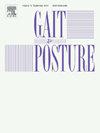我们可以共享数据吗?-在三个不同的基于跑步机的实验室中行走时的运动学一致性
IF 2.2
3区 医学
Q3 NEUROSCIENCES
引用次数: 0
摘要
三维步态分析对诊断和治疗计划至关重要。基于跑步机的实验室有效地收集了许多连续步骤的3D步态数据。在基于跑步机的实验室之间汇集/共享数据可以提高临床效用。然而,基于跑步机系统的步态运动学的实验室间一致性是未知的。研究问题:在三种不同的基于跑步机的步态实验室中,健康受试者的下肢运动学测量的一致性如何?方法18名志愿者(女性14名;27 ± 9年;BMI 24 ± 3 kg/m2)在三个基于跑步机的实验室(荷兰Motek Medical)中行走一周。每个实验室,参与者穿着不负重的背带和相同的衣服和鞋子完成了3分钟的步行试验(0.9,1.1,1.3 米/秒)。使用相同的标记集(人体模型2)和虚拟现实配置。使用统计参数映射来比较实验室之间下肢的时间归一化运动曲线,平均超过40步。当>; 5°时,在步态周期内计算的均方根差异(RMSD)具有统计学显著性差异,认为具有临床意义。所有实验室的运动学曲线都遵循相似的模式。只有17% %的曲线显示出临床相关的差异。这些差异包括实验室2的膝关节屈曲度高于其他实验室(RMSD 6.0-8.6°),实验室3的髋关节屈曲度低于实验室2(所有速度)和实验室1(1.3 m/s;RMSD 5.4 - -6.4°)。报告的差异可能是由于不同的操作员协议,而不是测量系统。研究结果表明,使用这种基础设施进行实验室间数据共享是可能的,但必须进行协调协议的培训。本文章由计算机程序翻译,如有差异,请以英文原文为准。
Can we share data? – Kinematic consistency during walking in three different treadmill-based laboratories
Background
Three-dimensional gait analysis is crucial for diagnosis and treatment planning. Treadmill-based laboratories efficiently collect 3D gait data over many consecutive steps. Pooling/sharing data across treadmill-based laboratories could enhance clinical utility. However, the inter-laboratory consistency of gait kinematics from treadmill-based systems is unknown.
Research question
How consistent are lower-limb kinematics of healthy subjects measured in three different treadmill-based gait laboratories?
Methods
Eighteen volunteers (14 women; 27 ± 9 years; BMI 24 ± 3 kg/m2) walked in three treadmill-based laboratories (Motek Medical, The Netherlands) within one week. Per laboratory, participants completed 3-minute walking trials (0.9, 1.1, 1.3 m/s) wearing a non-weight-bearing harness and identical clothes and shoes. The same marker-set (Human-Body Model 2) and virtual reality configurations were used. Statistical Parametric Mapping was used to compare time-normalized kinematic curves of the lower-limb, averaged over 40 steps, between laboratories. Root mean square differences (RMSD) calculated over periods of the gait cycle with statistically significant differences were considered clinically meaningful when > 5°.
Results and significance
Kinematics curves from all laboratories followed similar patterns. Only 17 % of all curves displayed clinically relevant differences. These differences included more knee flexion in laboratory 2 compared to the others (RMSD 6.0–8.6°) and less hip flexion in laboratory 3 compared to laboratory 2 (all speeds) and to laboratory 1 (1.3 m/s; RMSD 5.4–6.4°). Reported differences are likely due to varying operator protocols rather than to the measurement system. The findings indicate that inter-laboratory data sharing using such infrastructure is possible but training to align protocols is essential.
求助全文
通过发布文献求助,成功后即可免费获取论文全文。
去求助
来源期刊

Gait & posture
医学-神经科学
CiteScore
4.70
自引率
12.50%
发文量
616
审稿时长
6 months
期刊介绍:
Gait & Posture is a vehicle for the publication of up-to-date basic and clinical research on all aspects of locomotion and balance.
The topics covered include: Techniques for the measurement of gait and posture, and the standardization of results presentation; Studies of normal and pathological gait; Treatment of gait and postural abnormalities; Biomechanical and theoretical approaches to gait and posture; Mathematical models of joint and muscle mechanics; Neurological and musculoskeletal function in gait and posture; The evolution of upright posture and bipedal locomotion; Adaptations of carrying loads, walking on uneven surfaces, climbing stairs etc; spinal biomechanics only if they are directly related to gait and/or posture and are of general interest to our readers; The effect of aging and development on gait and posture; Psychological and cultural aspects of gait; Patient education.
 求助内容:
求助内容: 应助结果提醒方式:
应助结果提醒方式:


